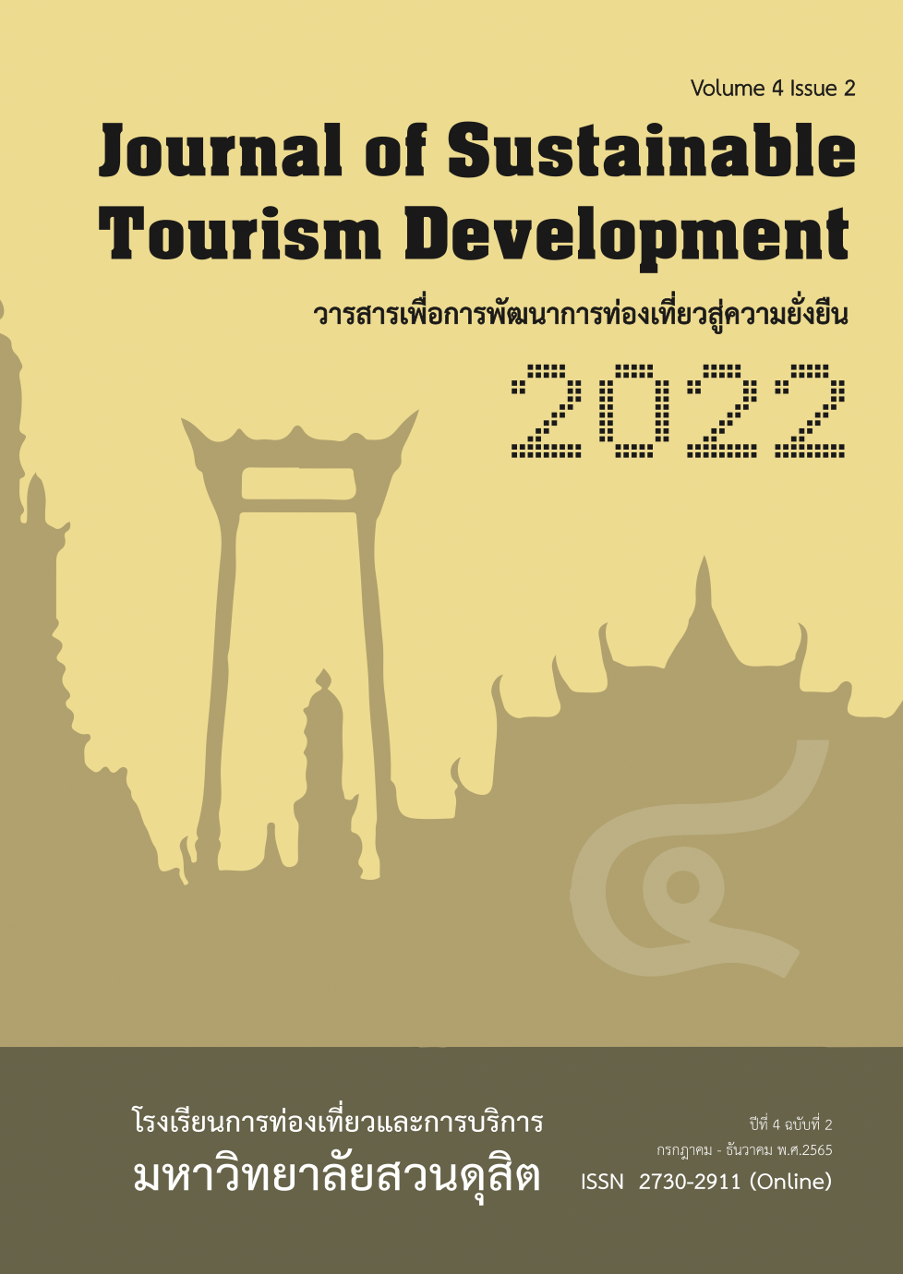The Push-Pull Motivation Factors of Generation Y Tourists and their Travel Intentions towards Thainess Tourism
Main Article Content
บทคัดย่อ
This study explores the push-pull motivation factors of Generation Y tourists and their travel intentions towards Thainess tourism based on quantitative research. The close-ended questionnaire survey was used to collect data from 400 Thai Gen Y tourists and 343 valid responses were received to test the proposed model. Data was analyzed using Structural Equation Modeling approach. The CFA results present an acceptable fit (x2= 790.388; df. = 397; RMSEA = 0.054; CFI = 0.928; TLI = 0.921; SRMR = 0.076) The results reveal that the knowledge and social relations are push motivations, and the atmosphere is a pull motivation and that they all significantly affect the Thai Gen Y’s satisfaction with travel in Thailand, with the atmosphere of a destination having the highest effect. This finding suggests that when Thai Gen Y tourists feel satisfied with their travel in Thailand, they are interested to specifically try the traveling for Thainess tourism program. The results of this research will guide tourism planners and lead to a better understanding of Thai Gen Y travelers’ motivations, satisfaction, and travel intentions.
Article Details

อนุญาตภายใต้เงื่อนไข Creative Commons Attribution-NonCommercial-NoDerivatives 4.0 International License.
ลิขสิทธิ์ต้นฉบับที่ได้รับการตีพิมพ์ในวารสารเพื่อการพัฒนาการท่องเที่ยวสู่ความยั่งยืน ถือเป็นกรรมสิทธิ์ของโรงเรียนการท่องเที่ยวและการบริการ มหาวิทยาลัยสวนดุสิต ห้ามผู้ใดนำข้อความทั้งหมดหรือบางส่วนไปพิมพ์ซ้ำ เว้นแต่จะได้รับอนุญาตอย่างเป็นลายลักษณ์อักษรจากโรงเรียนการท่องเที่ยวและการบริการ มหาวิทยาลัยสวนดุสิต นอกจากนี้ เนื้อหาที่ปรากฎในบทความเป็นความรับผิดชอบของผู้เขียน ทั้งนี้ไม่รวมความผิดพลาดอันเกิดจากเทคนิคการพิมพ์
เอกสารอ้างอิง
Cennamo, L., & Gardner, D. (2008). Generational differences in work values, outcomes and person-organization values fit. Journal of Managerial Psychology, 23(8), 891-906.
Cham, T. H., Ng, C. K. Y., Lim, Y. M., & Cheng, B. L. (2018). Factors influencing clothing interest and purchase intention: A study of Generation Y consumers in Malaysia. The International Review of Retail, Distribution and Consumer Research, 28(2), 174-189.
Correia, A., & Pimpão, A. (2008). Decision-making processes of Portuguese tourist travelling to South America and Africa. International Journal of Culture, Tourism and Hospitality Research, 2(4), 330-373.
Crompton, J. (1990). Claiming our share of the tourism dollar. Park and Recreation, 25(3), 42-88.
Dann, G. M. S. (1977). Anomie, ego-enhancement and tourism. Annals of Tourism Research, 4(4), 184-194.
Doosti, S., Jalilvand, M. R., Asadi, A., Pool, J. K., & Adi, P. M. (2016). Analyzing the influence of electronic word of mouth on visit intention: the mediating role of tourists’ attitude and city image. International Journal of Tourism Cities, 2(2), 137-148.
Fyall, A., Leask, A., Barron, P., & Ladkin, A. (2017). Managing Asian attractions, Generation Y and face. Journal of Hospitality and Tourism Management, 32(1), 35-44.
Hair, J., Black, W., Babin, B., Anderson, R., & Tatham, R. (2006). Multivariate data analysis (6thed.) Upper Saddle River, NJ: Pearson Prentice Hall.
Hair, J., Black, W., Babin, B., & Anderson, R. (2010). Multivariate data analysis: A Global Perspective. Upper Saddle River, NJ: Pearson Prentice Hall.
Heaney, J. (2007). Generations X and Y’s internet banking usage. Journal of Financial Services Marketing, 11(3), 196-210.
Hu, L. T., & Bentler, P. M. (1999). Cutoff criteria for fit indexes in covariance structure analysis: Conventional criteria versus new alternatives. Structural Equation Modeling: A Multidisciplinary Journal, 6(1), 1-55.
Isa, S. M., & Ramli, L. (2014). Factors influencing tourist visitation in marine tourism: lessons learned from FRI Aquarium Penang, Malaysia. International Journal of Culture, Tourism and Hospitality Research, 8(1), 103-117.
Kim, H. K., Lee, T. J., & Yoon, S. H. (2012). Factors affecting consumer’s choice of ethnic restaurants. Tourism Analysis, 17(3), 377-383.
Lai, I. K. W., Hitchcock, M., Lu, D., & Liu, Y. (2018). The influence of word of mouth on tourism destination choice: Tourist–resident relationship and safety perception among mainland Chinese tourists visiting Macau. Sustainability, 10(7), 2114. https://doi.org/10.3390/su10072114
Lim, Y. J., Kim, H. K., & Lee, T. J. (2016). Visitor motivational factors and level of satisfaction in wellness tourism: Comparison between first-time visitors and repeat visitors. Asia Pacific Journal of Tourism Research, 21(2), 137-156.
Ma, A. T. H., Chow, A. S. Y., Cheung, L. T. O., Lee, K. M. Y., & Liu, S. (2018). Impacts of tourists’ sociodemographic characteristics on the travel motivation and satisfaction: The case of protected areas in South China. Sustainability, 10(10). 3388. https://doi.org/10.3390/su10103388
Ministry of Tourism and Sports (2020). Tourism statistics 2019. Retrieved September 10, 2021, from https://www.mots.go.th/mots_en/more_news_new.php?cid=316
Moscardo, G., Murphy, L., & Benckendorff, P. (2011). Generation Y and travel futures. In Tourism and Demography. Oxford, UK: Goodfellow Publishers.
Pattanapokinsakul, K., & Pahkdee-Auksorn, P. (2017). Analysis of push and pull travel motivation of foreign tourist to local markets: A case study of Phuket, Thailand. Journal of International and Thai Tourism, 11(2), 43-63.
Pongajarn, C., van der Duim, R., & Peters, K. (2014). Reading postcards: Multiple enactments of tourism destinations. The case of Pai, Thailand. International Journal of Tourism Sciences, 14(1), 71-91.
Preko, A., Doe, F., & Dadzie, S. A. (2019). The future of youth tourism in Ghana: Motives, satisfaction and behavioural intentions. Journal of Tourism Futures, 5(1), 5-21.
Somruedi Banchongduang. (2019). Millennials mired in shopping debts. Retrieved September 13, 2021, from https://www.bangkokpost.com/business/1802209/millennials-mired-in-shopping-debts
Sopha, C., Jittithavorn, C., & Lee, T. J. (2019). Cooperation in health and wellness tourism connectivity between Thailand and Malaysia. International Journal of Tourism Sciences, 19(4), 248-257.
Sullivan, P., & Heitmeyer, J. (2008). Looking at Gen Y shopping preferences and intentions: Exploring the role of experience and apparel involvement. International Journal of Consumer Studies, 32(3), 285-295.
Thach, E. C., & Olsen, J. E. (2006). Market segment analysis to target young adult wine drinkers. Agribusiness, 22(3), 307-322.
Thailand Board of Investment. (2021). Demographic information. Retrieved September 13, 2021,
from https://www.boi.go.th/index.php?page=demographic
Tourism Authority of Thailand. (2016). Discover Thainess tourism campaign to continue in 2016. Retrieved January 7, 2017, from www.discoverthiness.tourismthailand.org
United Nation World Tourism Organization. (2020). The power of youth travel. Retrieved January 13, 2020, from https://www.wysetc.org/about-us/facts-and-stats/
Uysal, M., & Jurowski, C. (1994). Testing the push and pull factors. Annals of Tourism Research, 21(4), 844-846.
Zhang, Y., Oh, H. -K., & Lee, C. H. (2021). Understanding consumer switching intention of peer-to-peer accommodation: A push-pull-mooring framework. Journal of Hospitality and Tourism Management, 49(3), 321-330.

